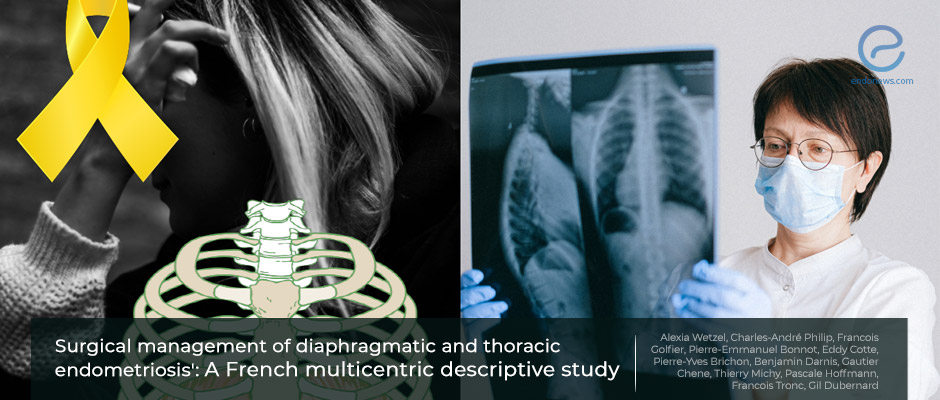Surgery for the Treatment of Endometriosis of the Diaphragm and Thorax
Mar 23, 2022
There is currently no standardized procedure and treatment in diaphragmatic and thoracic endometriosis so it is very important to systematically look for chest pain in patients with endometriosis.
Key Points
Highlights:
- Diaphragmatic and thoracic endometriosis is a progressive disease starting in the diaphragmatic abdominal wall and spreading to the thorax.
- There is no standardized approach to treat diaphragmatic and thoracic endometriosis.
- Chest pain should be systematically investigated in patients with pelvic endometriosis.
Importance:
- This study provides information about the largest series of patients treated with surgery for diaphragmatic and thoracic endometriosis and provides clues as to which surgical approach (thoracic or abdominal) might be the best.
What's done here:
- Researchers conducted a retrospective study in eight thoracic, gynecology, or digestive surgery units in five university hospitals in France.
- 50 women had surgery to treat their diaphragmatic and thoracic endometriosis between 2010 and 2017.
Key results:
- 25 patients had preoperative pelvic endometriosis.
- 26 patients were treated with the thoracic, and 24 were treated with the abdominal approach. 22 of them had pelvic endometriosis surgery at the same time.
- 19 women had pneumothorax, 18 had chronic or catamenial chest pain, and one had hemopneumothorax, which led to their diagnosis.
- 42 women had diaphragmatic nodules, 22 had diaphragmatic perforations, and five had pleuropulmonary nodules.
- 31 women needed diaphragmatic reconstruction.
- Diaphragmatic and thoracic endometriosis resection was considered complete in 46 women.
- 3 women had severe complications within 30 days following surgery.
- The disease recurred in 10 women.
Lay Summary
Diaphragmatic and thoracic endometriosis starts in the abdominal wall of the diaphragm and later invades the thorax, based on findings from a series of patients surgically treated for the disease, reports a study published in the Journal of Gynecology Obstetrics and Human Reproduction.
Therefore, early diagnosis is of great importance, according to Dr. Alexia Wetzel and the co-others of the study who stress that chest pain should be systematically investigated in patients experiencing pelvic endometriosis.
To review the current management of diaphragmatic and thoracic endometriosis, the team of researchers conducted a multicentric retrospective study in thoracic, gynecologic, or digestive surgery units between 2010 and 2017.
During that time, 50 patients were operated on for diaphragmatic and thoracic endometriosis. Almost half of the patients (26) were treated with the thoracic approach and the other half (24) with the abdominal approach. Half of the patients had pelvic endometriosis before the operation.
Diaphragmatic and thoracic endometriosis was diagnosed based on symptoms such as pneumothorax, hemopneumothorax, and chest pain in 38 patients.
Diaphragmatic nodules were found in 42 of the patients. Twenty-two patients had diaphragmatic perforations and five had pleuropulmonary nodules because of the disease. These nodules were destructed in 12 patients and resected in 38 patients.
A total of 31 patients needed diaphragmatic reconstruction, of which 26 received a simple suture while five needed a mesh repair.
The resection was considered complete in 46 patients. Three patients had severe complications within 30 days following surgery and 10 had their disease recur.
The researchers reported that the thoracic approach seemed more associated with more complete surgery and decreased recurrence. However, one drawback of this approach is that it cannot be used to treat pelvic lesions. The abdominal approach, on the other hand, can treat both pelvic and diaphragmatic lesions. However, it increases the risk of leaving behind smaller thoracic lesions and seems to have a higher risk of recurrence.
The team concluded that an extensive exploration before surgery should always be offered to patients with diaphragmatic and thoracic endometriosis and a combined approach should be considered.
Research Source: https://pubmed.ncbi.nlm.nih.gov/33862264/
diaphragmatic and thoracic endometriosis endometriosis surgery chest pain recurrence pleura lung mesh

